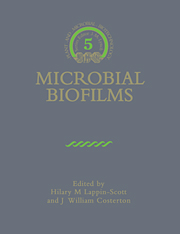Book contents
- Frontmatter
- Contents
- List of Contributors
- Series Preface
- Introduction to Microbial Biofilms
- Part I Structure, Physiology and Ecology of Biofilms
- Part II Biofilms and Inert Surfaces
- 7 Biofilm Development in Purified Water Systems
- 8 Mineralized Bacterial Biofilms in Sulphide Tailings and in Acid Mine Drainage Systems
- 9 Biofilms and Microbially Influenced Corrosion
- 10 Microbial Consortia in Industrial Wastewater Treatment
- 11 Heterogeneous Mosiac Biofilm – A Haven for Waterborne Pathogens
- Part III Biofilms on the Surfaces of Living Cells
- Index
8 - Mineralized Bacterial Biofilms in Sulphide Tailings and in Acid Mine Drainage Systems
Published online by Cambridge University Press: 24 November 2009
- Frontmatter
- Contents
- List of Contributors
- Series Preface
- Introduction to Microbial Biofilms
- Part I Structure, Physiology and Ecology of Biofilms
- Part II Biofilms and Inert Surfaces
- 7 Biofilm Development in Purified Water Systems
- 8 Mineralized Bacterial Biofilms in Sulphide Tailings and in Acid Mine Drainage Systems
- 9 Biofilms and Microbially Influenced Corrosion
- 10 Microbial Consortia in Industrial Wastewater Treatment
- 11 Heterogeneous Mosiac Biofilm – A Haven for Waterborne Pathogens
- Part III Biofilms on the Surfaces of Living Cells
- Index
Summary
Introduction
The disposal of sulphide bearing mine wastes (tailings) as open deposits results in the formation of unique acid generating ecosystems (Mills 1985). Acid formation occurs via biooxidation of mineral sulphides which generates dilute solutions of sulphuric acid containing soluble metalions. The microorganisms (predominantly acidophilic thiobacilli) responsible for this mineral oxidation exist as discrete biofilms obtaining energy for their metabolism from the sulphide mineral surfaces which they colonize (Norman & Snyman 1987; Southam & Beveridge 1992). Most references to biofilms conjure up images of thick layers of bacteria (>100 μm) encased in capsular material. In this chapter we will employ the term ‘discrete biofilm’ to refer to the colonization of mineral surfaces by Thiobacillus ferrooxidans which typically exist as a single cell layer that is devoid of capsule. In this context a biofilm is simply a metabolically active surface at a solid solution interface.
Bacterial leaching produces acid mine drainage (AMD) which seeps into the surrounding aquatic and terrestrial environments. AMD is of environmental concern not only because of its acidity but also because of the soluble heavy metals which may enter the eukaryotic food chain (Schofield 1976; Tamm 1976; Koryak et al. 1979; Cloutier et al. 1986). Sometimes bacterial leaching can be exploited for industrial purposes, for example in the recovery of copper or uranium (Brierly 1982). Bacterial oxidation is, then, both an economic liability due to the legislated costs associated with AMD neutralization and an economic benefit as evidenced in industrial leaching systems. Clearly, an understanding of the fundamental aspects of bacteria mineral interaction is essential for the prevention of this deleterious environmental impact and for the promotion of these industrial bio oxidative processes.
- Type
- Chapter
- Information
- Microbial Biofilms , pp. 148 - 170Publisher: Cambridge University PressPrint publication year: 1995
- 7
- Cited by



